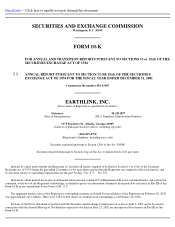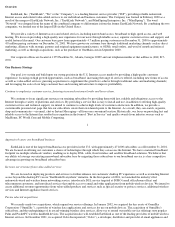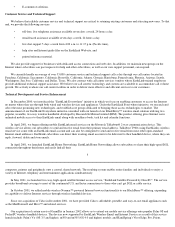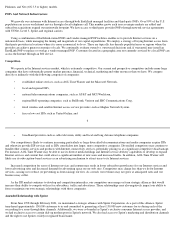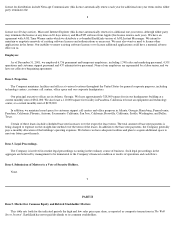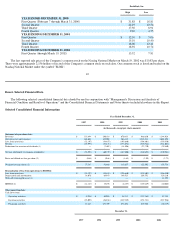Earthlink 2001 Annual Report Download - page 8
Download and view the complete annual report
Please find page 8 of the 2001 Earthlink annual report below. You can navigate through the pages in the report by either clicking on the pages listed below, or by using the keyword search tool below to find specific information within the annual report.
Platinum, and Neo (OS 3.5 or higher) models.
POPs And Network Infrastructure
We provide our customers with Internet access through both EarthLink managed facilities and third-party POPs. Over 90% of the U.S.
population can access our Internet service through a local telephone call. This number grows each year as unique markets are added and
subscriber acquisitions expand our nationwide footprint. We have access to third-party provider POPs through network service agreements
with UUNet, Level 3, Sprint, and regional carriers.
Using a combination of EarthLink-owned POPs and vendor-managed POP facilities enables us to provide Internet services on a
nationwide basis, while managing the timing and magnitude of our capital expenditures. We employ a strategy of buying Internet access from
third-party providers in locations where it is more economical to do so. These are typically less densely populated areas or regions where the
provider can achieve greater economies of scale. We continually evaluate owned vs. outsourced decisions and, if warranted, may install an
EarthLink POP to replace or overlap a vendor-
managed POP. Customers located in a geographic area not currently serviced by a local POP can
access the Internet through an 800 service.
Competition
We operate in the Internet services market, which is extremely competitive. Our current and prospective competitors include many large
companies that have substantially greater market presence, financial, technical, marketing and other resources than we have. We compete
directly or indirectly with the following categories of companies:
• established online services, such as AOL Time Warner and the Microsoft Network,
• local and regional ISPs,
• national telecommunications companies, such as AT&T and MCI Worldcom,
• regional Bell operating companies, such as BellSouth, Verizon and SBC Communications Corp,
• fixed wireless and satellite Internet access service providers such as Hughes Network System,
• free or low cost ISPs such as United Online, and
6
• broadband providers such as cable television, utility and local and long distance telephone companies.
Our competition is likely to continue increasing particularly as large diversified telecommunications and media companies acquire ISPs
and otherwise provide ISP services and as ISPs consolidate into larger, more competitive companies. Diversified competitors may continue to
bundle other content, services and products with Internet connectivity services, potentially placing us at a significant competitive disadvantage.
For instance, AOL Time Warner may be able to use its diverse media holdings and Internet service delivery capabilities to develop or expand
Internet services and content that could attract a significant number of new users and increased traffic. In addition, AOL Time Warner will
likely use its subscription-based services as an advertising mechanism to attract users to its Internet services.
Increased competition for users of Internet services and content may result in lower subscriber growth rates for our Internet services and
lower advertising rates and decreased demand for advertising space on our web sites. Competitors may charge less than we do for Internet
services, causing us to reduce (or preventing us from raising) our fees. As a result, our revenues may not grow at anticipated rates and our
business may suffer.
As the ISP market continues to develop and competition intensifies, our competitors may merge or form strategic alliances that would
increase their ability to compete with us for subscribers, traffic and advertisers. These relationships may also negatively impact our ability to
form or maintain our own strategic relationships with those companies.
Amended Relationship with Sprint
From June 1998 through February 2001, we maintained a strategic alliance with Sprint Corporation. As a part of this alliance, Sprint
transferred approximately 130,000 customers to us and committed to generating at least 150,000 new customers for us during each of the
succeeding five years through their channels. Additionally, we were co-branded as Sprint's exclusive consumer Internet access provider, and
we had exclusive access to certain dial-up modem ports in Sprint's network. We also had access to Sprint's marketing and distribution channels
and the right to use Sprint's widely recognized brand name.


